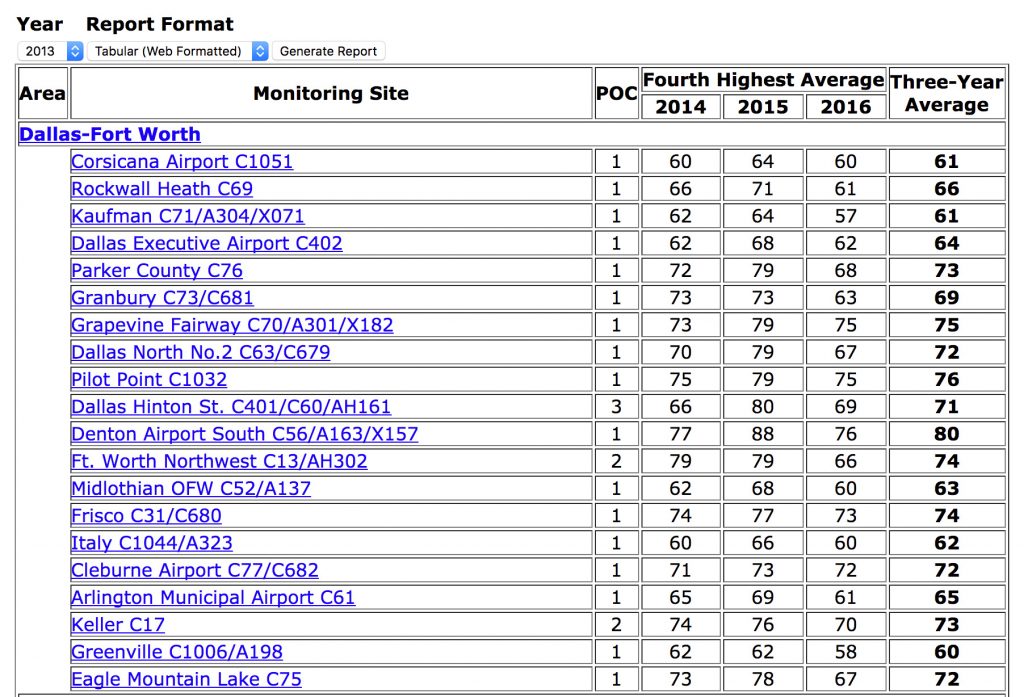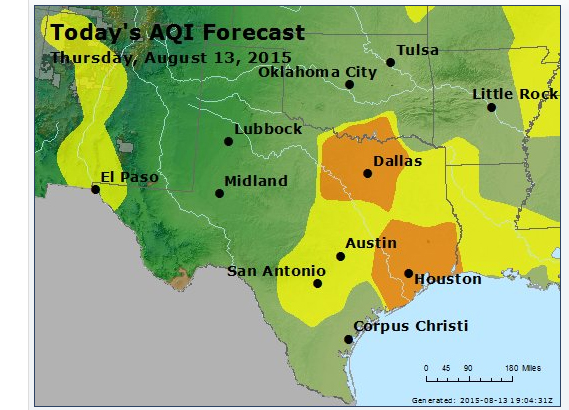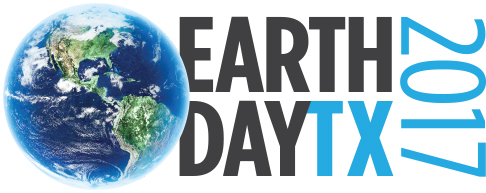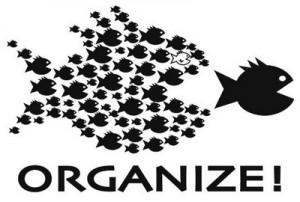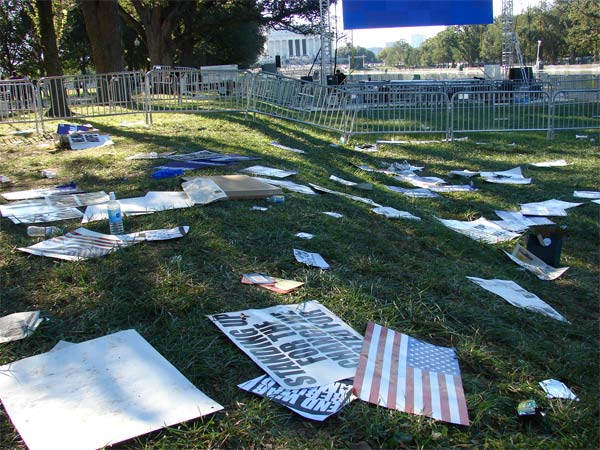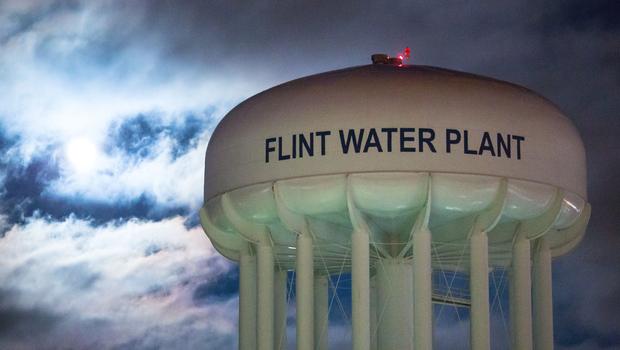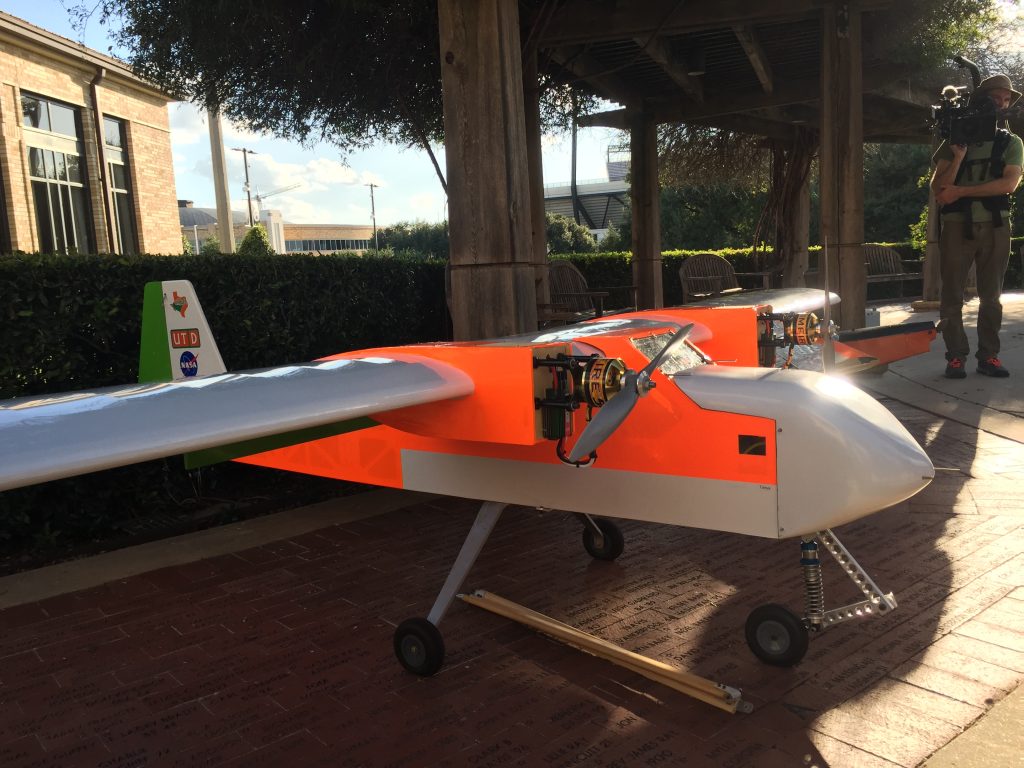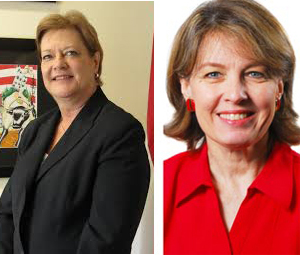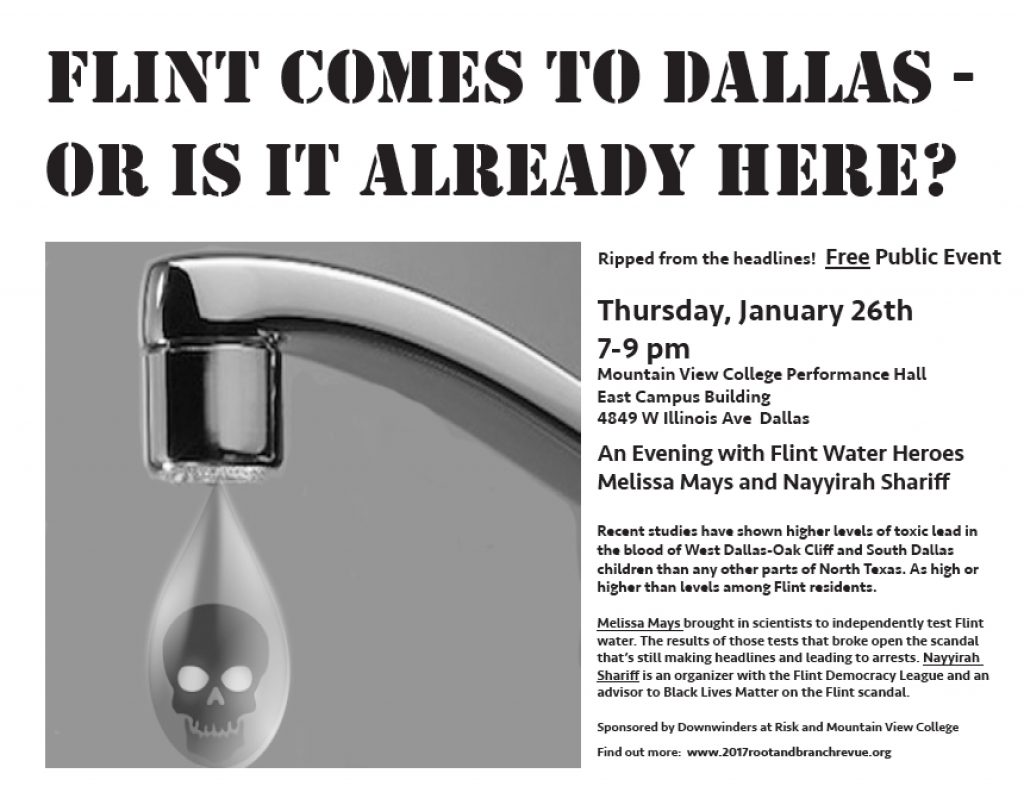Citizen Science
Downwinders Buys Smog Monitors to Go Where No Smog Monitor Has Gone Before: Wise County
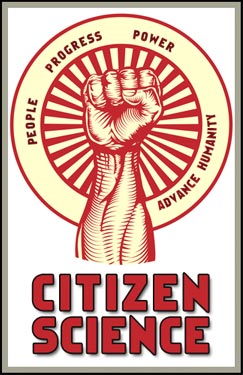 On the eve of Earth Day, clean air group Downwinders at Risk announced the purchase of two portable, EPA-calibrated ozone monitors to initiate a citizen-based monitoring campaign in Wise County this summer, where state officials refuse to measure DFW smog.
On the eve of Earth Day, clean air group Downwinders at Risk announced the purchase of two portable, EPA-calibrated ozone monitors to initiate a citizen-based monitoring campaign in Wise County this summer, where state officials refuse to measure DFW smog.
“With the purchase of these brand new high-tech monitors, which reached the market only a few months ago, we become the first group in Texas to have the capability to go out in the field and do the job the State of Texas isn’t willing to do,” said Downwinders Chair Tamera Bounds.
Downwinders newest technology will be on display at this weekend’s Earth Day Texas at Fair Park, where it’ll be a featured part of the group’s information booth. Each monitor cost approximately $5,000, fits in the palm of your hand, and comes with EPA-certified calibration to ensure reliable readings.
Wise County became the newest member of DFW’s almost-30 year “non-attainment” area for smog, or ozone pollution, in 2012. But despite computer models showing the County having some of the highest smog levels North Texas, there’s still no smog monitor located there.
Surprisingly, EPA regulations don’t require even a single ozone monitor in every non-attainment county, and Wise County is the only one of the ten DFW non-attainment counties not to have one. Bounds and her fellow clean air activists don’t believe that’s a coincidence.
Currently the Texas Commission on Environmental Quality (TCEQ) picks the sites where smog monitors are located. Denton’s airport monitor has recorded the highest levels of smog in DFW the last few years. But because of wind direction and its large number of pollution sources, computer models predict even higher levels of smog in Wise County.
That’s important because the size and scope of local clean air plans are determined by how high or low smog readings are in North Texas. The higher the smog levels, the more cuts in pollution from coal plants, cement kilns, and gas industry facilities are required to comply with the Clean Air Act.
 Not surprisingly, spoke persons for those industries claim such cuts aren’t needed, but the state has made the same claims despite evidence from their own computer models showing new controls could bring the area into compliance with the Clean Air Act for the first time since 1991. TCEQ also takes the position, contrary to the medical consensus, that smog isn’t bad for public health.
Not surprisingly, spoke persons for those industries claim such cuts aren’t needed, but the state has made the same claims despite evidence from their own computer models showing new controls could bring the area into compliance with the Clean Air Act for the first time since 1991. TCEQ also takes the position, contrary to the medical consensus, that smog isn’t bad for public health.
Bounds believes the TCEQ doesn’t want a smog monitor in Wise County precisely because it’d record even higher levels of the pollution than current monitors are picking up and trigger regulatory requirements to make bigger cuts.
“By not measuring smog in the place it’s predicted to be the worst, what we don’t know is hurting us,” she explained.
“Because TCEQ’s priority is to protect a handful of industrial polluters at the expense of seven million DFW residents we’re getting clean air plans based on one, rosier set of numbers, while the actual pollution levels are probably higher. That’s one reason why we’ve been in continual violation of the Clean air Act since 1991.”
Downwinders Director Jim Schermbeck said the two monitors, and others the group is buying, would be used both in stand-alone stationary locations within the County and by vehicle and drone -based platforms. They can be adapted to provide wireless connections and be plugged-in to larger networks of citizen-based monitors – something already being designed by a consortium of local universities, municipalities, and citizen groups co-founded by Downwinders.
On “high ozone days,” Downwinders will scramble a crew of citizen scientists to record ozone levels in Wise County a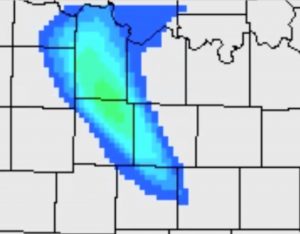 nd compare their results to those from other DFW monitors.
nd compare their results to those from other DFW monitors.
Besides giving the public and policymakers a more realistic view of DFW smog levels, Downwinders hope to put pressure on the EPA and the State to place one or more official ozone monitors in Wise County. Schermbeck said the group’s efforts at identifying patterns or hotspots in the County would help clean air advocates find the best place to put such a monitor.
Although the purchased monitors only arrived on the market in January, Downwinders’ Wise County Ozone Project has been over a year in planning.
It was as last year’s Earth Day Texas that Downwinders won a $3000 prize with its proposal to use small electronic air sensors combined with drone technology to provide better air pollution measurements across DFW. Wise County smog was one of the specific examples used in the presentation.
Downwinders used the Earth Day Texas funding as seed money to attract other support to fund its own North Texas CLEAN Air Force – a citizen science campaign whose first target is Wise County smog. With the purchase of the monitors, it’s believed to be the only citizens’ group in the state with the ability to independently measure ozone pollution with its own devices, much less with EPA-calibrated instruments.
Schermbeck says the group is looking to recruit both researchers who want to lend their professional help to the project, and those people who just want to help do their part in a local fight for cleaner air.“ Sadly, this is what it’s come down to in 2017 Texas: residents having to organize themselves into performing basic public health functions usually carried out by their state government.”
Have You Seen Me? The Missing DFW Clean Air Plan
 Somewhere deep in the cubicled bowels of the Region 6 EPA offices in downtown Dallas lies a draft of a letter to the State of Texas telling Austin it’s proposed clean air plan for DFW is inadequate and must be re-written.
Somewhere deep in the cubicled bowels of the Region 6 EPA offices in downtown Dallas lies a draft of a letter to the State of Texas telling Austin it’s proposed clean air plan for DFW is inadequate and must be re-written.
It likely goes through the litany of well-known public objections the EPA has about the plan, originally expressed while it was being drafted by the Texas Commission on Environmental Quality:
- The state’s computer air modeling’s predictions of drops in pollution are “unrealistic.”
- The state’s plan doesn’t do anything about pollution from the old East Texas coal plants despite evidence “strongly supporting” the link between their poisons and DFW smog.
- Air quality monitors in the gas patch are lagging behind other DFW area monitors in showing decreases in smog over the last decade, indicating pollution from gas patch facilities is slowing air quality progress, but the state’s plan doesn’t reduce it either.
- Despite a brand new state-of-the-art pollution control system that could cut smog pollution by 70-90% being voluntarily installed at one cement kiln in Midlothian, the state is not requiring the other three kilns install the same technology.
Which is all longhand for “this plan is not cutting enough air pollution to work.”
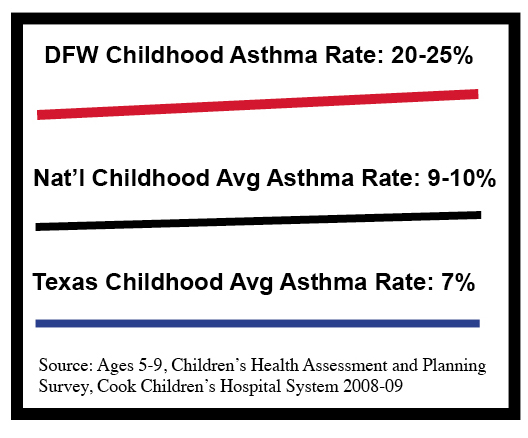 The current standard for smog, or ozone pollution, is 75 parts per billion over an eight hour period. That’s supposed to come down to 70 in the next few years as a new, more protective federal standard is applied.
The current standard for smog, or ozone pollution, is 75 parts per billion over an eight hour period. That’s supposed to come down to 70 in the next few years as a new, more protective federal standard is applied.
DFW’s eight hour average is 80 parts per billion at the start of this “ozone season.” (based on the numbers coming out of the Denton air quality monitor) The North Texas region has never been in compliance with the smog standard, even when it was 120 parts per billion over just an hour. That’s 26 years of bad air and counting.
The state’s plan is supposed to be response to this problem, but for the second time in a row, Texas has written an air plan for DFW that does nothing at all.
Before November, that plan was going to be rejected, in part, or whole, as insufficient by EPA, sent back to Austin for a re-write and then, fingers crossed, Downwinders and others were hoping to persuade the Agency to substitute its own federal plan of action. That would have been a first for DFW.
In December, Dallas County Commissioner Dr. Theresa Daniel, Dallas Council member Sandy Greyson, Dallas Mayor Mike Rawlings, staff representing Congresswoman Eddie Bernice Johnson and Congressman Marc Veasey, members of the Dallas County Medical Society and Downwinders members all pleaded with EPA Regional Administrator Ron Curry to try and persuade him to reject the state plan and implement a federal one before Inauguration Day.
Curry’s response was to say that timeline was too fast – despite having had the state plan in-house at EPA for over a year, and access to its conclusion for even longer. Plus, he said reassuringly, they’d all gone through “transitions” from one administration to another. Everything would be all right.
Donald Trump will not be able to revive the coal industry. He will not be able to revoke President Obama’s climate change policies en masse without court fights. Meta national and international trends are beyond his gutted EPA’s reach to impact. But he can keep seven million DFW residents from breathing safe and legal air for the next decade.
Right now, the state clean air plan for DFW is still parked at EPA. Because of the change in administrations, the staff is probably being told to do the math twice and make only the most conservative calls. That may mean rejecting only certain parts of the plan, albeit critical ones, like the section that promises to get down to 75 ppb by the end of this summer.
Yes, that was the original goal of the plan way back when it started being put together in 2014-15. If we have another cooler, wetter summer it’s possible we could get close. If we have a typical DFW summer, the smog might get worse, as it did the last time a state clean air plan that did nothing was being implemented in 2011.
Besides rejecting the “attainment” part of the attainment plan, the EPA could also reject the way the state defined new control technologies as impractical or too costly despite being widely used in industry. One example is electrification of compressors in the gas patch. Even the gas and oil’s industry’s own textbooks cite this one simple switch in power sources, from diesel or gas to electricity to power huge, locomotive size pipeline compressors, as being the standard fix in metropolitan areas with bad air.
But the state’s rejecting requiring electrification because it says it just isn’t practical to expect that those compressors can find power close enough to the grid to plug-in….in the fourth largest urban area in the country.
Another example are the three Midlothian cement plants, still the single largest sources of air pollution in DFW.
One cement plant operator has voluntarily installed what’s considered to be a state-of-the art pollution control system that’s capable of reducing smog-forming emissions by 70-90%. This system is also being used with great effect in Europe on almost a dozen plants. But the state’s plan doesn’t take note of this sea-change in technology and doesn’t require the other three cement plants in Midlothian to install it, saying it hasn’t been proven yet – even though it’s in full scale operation in a Texas cement kiln right now.
But while the local EPA staff may have felt more confident about making those calls on new pollution controls in a Clinton administration, it’s unlikely they’ll advocate for them now, knowing their new bosses in DC will not approve.
So they’ll put a big’ ol “REJECT” stamp on the state’s paperwork and and send it back to Austin for a redo.
From where it will never see the light of day again.
Officially, when the EPA rejects a state clean air plan, it triggers a two-year deadline to come up with another one. So normally, the state would go through the motions and eventually churn out another plan, it would be found inadequate by EPA again, the whole thing would wind up in court and either the EPA and/or environmentalists would win some concessions.
But the EPA is transitioning from one smog standard to another. There’s a gap in enforcement of the old standard to get ready for the new one. So the State of Texas, which hasn’t even tried to write a serious clean air plan in decade, and doesn’t even believe smog is bad for you, will get a Mulligan from the EPA for not being able to produce a clean air plan for DFW that works.
Not only will the state of Texas not be penalized for writing an ineffective clean air plan, but if DFW is still not in compliance with the older 75 ppb smog standard by the end of this summer, it won’t be penalized for that either. Because now the EPA is switching over to the 70 ppb standard – and there are brand new deadlines for brand new clean air plans….for the State of Texas to willfully ignore.
Greg Abbott will not be punished for ignoring the law. The Texas Legislature will not be punished. Nobody at TCEQ will pay a price for once again not doing their job.
No, the only people being punished for the state’s aggressive neglect of its air are DFW’s residents, who must breathe the results of that neglect for almost half of every year now. Make no mistake about it, it’s a statistical certainty that neglect is killing people and making them sick. Dr. Robert Haley’s landmark study using the state and EPA’s own data shows that number could be as high as 100 victims a year.
Now add a Trump EPA to the mix.
DFW is not in compliance with the current/old 75 ppb smog standard. The Texas plan to get it in compliance is inadequate. The leftover Obama EPA will say so and send it back to Austin. The state will sit on the plan six months, then resubmit it. A Trump EPA will now find this previously inadequate plan quite adequate, even if the region still isn’t in compliance with the old standard.
But wait, there’s more.
You’d think a region in continual non-compliance with the Clean Air Act for almost three decades would be a priority for receiving an effective clean air plan. You’d be wrong.
In fact, since DFW average is currently 80 ppb of smog, and not 81 ppb, the state of Texas does not even have to submit a clean air plan for DFW until AFTER the region fails to meet the new 70 ppb standard by 2020, at which point Texas will have two more years to write another plan that does nothing.
This is how 80,000 votes spread over three Midwestern states can poison the air for seven million Texans.
The one thing that could throw a wrench into this scenario? Court cases filed by environmentalists to make sure EPA doesn’t allow backsliding in DFW air quality. But that is a very thin green line on which your lungs can pin hope, and it will always be after the barn door has already been left for too long.
We’ve gone from being on the precipice of what would have been the first real pollution reduction plan for DFW in a decade, to now looking at a decade of no action at all outside that which we can generate as citizens defending ourselves. In 2017, Environmental protection in Texas is very much a Do-It-Yourself proposition.
As the region’s only group charged with the job of protecting our air, Downwinders is looking at starting from scratch and reassessing our strategy. We have to find new ways to leverage our need for safe and legal air. We worked hard for over three years to win a good air plan. Now it’s back to the drawing boards.
One of the things we’re putting a lot of effort and money into building is our own independent air quality monitoring network. There are only 20 smog monitors for all of North Texas, half of which are used in rural areas for boundary readings. There are no smog monitors in Wise County, despite all the computer models showing it to be where the highest levels of the pollution are probably located.
If we can do a better job of documenting bad air, we make the case for why we need more actions to reduce air pollution, instead of do-nothing plans from Austin.
Downwinders Participates in First Earth Day Texas Oil and Gas Symposium
Downwinders at Risk is proud to be taking part in the first annual Responsible Shale Energy Extraction (RSEE) Symposium & Exposition, happening over two days at this year’s at Fair Park in Dallas, Friday April 21st and Saturday, April 22nd.
Climate Change superstar Dr. Katherine Hayhoe, Fracking health-effects lecturer (and Downwinder friend) Dr. Anne Epstein, and the Texas Railroad Commission’s own Ryan Sitton will also be participating, along with lots of others.
UTA’s Collaborative Laboratories for Environmental Analysis and Remediation, or (CLEAR) is the event’s primary sponsor and organizer, with an assist from the Cynthia and George Mitchell Foundation in Houston. Some of you may know the late George Mitchell as the inventor of fracking, but even he had serious second thoughts about the way the technology was being used.
The Symposium is an attempt to round-up scientists, industry advocates, environmental groups, and technology developers to talk both about fracking’s very real problems, and possible solutions, in an open forum.
 Since 2012 CLEAR has been out and about collecting samples throughout the Barnett Shale and other plays, identifying surface water and groundwater contamination issues that may or may not be directly linked to fracking itself. This is the first time in its history the group has taken on the task of sponsoring a two-day conference. Almost every aspect of unconventional shale mining, or hydraulic fracturing, will try to be addressed.
Since 2012 CLEAR has been out and about collecting samples throughout the Barnett Shale and other plays, identifying surface water and groundwater contamination issues that may or may not be directly linked to fracking itself. This is the first time in its history the group has taken on the task of sponsoring a two-day conference. Almost every aspect of unconventional shale mining, or hydraulic fracturing, will try to be addressed.
Everything is being run out of “The Westminster Abby of Texas,” Fair Park’s own Hall of State. A complete schedule is available here.
Downwinders’ Director Jim Schermbeck appears as part of a roundtable discussion on fracking in general, comparing the perspectives of landowners, gas operators, public health and environmental advocates and scientists. It includes water entrepreneurRichard Seline (AccelerateH20), TRRC Commissioner Ryan Sitton,Laura Buchanan, Executive Director of the Texas Land & Mineral Owners Association , and UTA’s own Kevin Schug.
Maybe you’ll want to come by The Hall of State Friday and mention to Commissioner Sitton how much you dislike the fact that BlueStone wants to put a new injection well on the shores of Lake Arlington. Or show-up on Saturday to see Dr. Hayhoe wow ’em again. But anytime you decide to visit Earth Day Texas, please make sure you come by and say hello to us at the Downwinders table over in the Centennial Building.
2017 R&B in pics
Scientists, Officials, and Activists: All in One Day
One- Day University of Change
Tomorrow – Saturday Jan. 28th
Two tracks of workshops going on all day
9:30-5:50
Walk-Ups Welcome
$35 for workshops plus lunch
$20 for students
Bluebonnet Ballroom, UTA Univ. Center
300 West First Street, Arlington
It only happens once a year
Flint Water Protectors!
Local Elected Officials in a Q&A!
Drones!
Lawyers! Scientists! Activists!
SCHEDULE
9:00- 9:30 am Morning Registration
9:45-10:45 am
Classroom #1
The Dos and Don't of Citizen Health Surveys
Leslie Allsop, University of Texas Health Science Center Classroom
Classroom #2
Using Science to Make Violations Stick
Tamera Bounds, Mansfield Gaswell Awareness and Downwinders at Risk, with Ranjana Bhandari of Livable Arlington
11:00 am – 12:00 Noon
Classroom#1
Citizen Monitoring of Drinking Water
Doug Carlton of UTA's C.L.E.A.R.
Classroon #2
State of the Air – An Asthma Forecast
Shammara Norris, Asthma Chasers
LUNCHTIME FORUM
12-1 pm
Catered Lunch
Local elected officials talk about protecting their quality of life goals in the face of state and federal opposition
Dallas County Commissioner Theresa Daniel
Dallas City Council Member Sandy Greyson
Fort Worth City Council Member Ann Zedah

1:15 -2:15 pm
Classroom#1
Fighting Environmental Permits in Texas
Ilan Levin, Attorney, Environmental Integrity Project
Classroom#2
Petition Rights: The Source of Citizen Power to Take Back Their Towns
Linda Curtis, Independent Texans
2:30 – 3:30 pm
Classroom#1
Strategy vs Tactics
Jim Schermbeck, Downwinders at Risk
Classroom#2
Door-to-Door Outreach
Corey Troiani, Texas Campaign for the Environment
3:45 – 4:45
Classroom #1
High Tech Tools for Citizens
Dr. David Lary, University of Texas @ Dallas, Doug Carlton, University of Texas @ Arlington, Jim Schermbeck, Downwinders at Risk

Classroom #2
How Flint was Exposed
Melissa Mays, Water You Fighting For and Nayyirah Shariff, Flint Rising
5:00 – 5:30
Air Sampling and Monitoring Drone Demonstration (weather permitting)

5:30
Happy Hour Networking
REGISTER HERE NOW
OR WALK-UP ON SATURDAY
(It's a secure Click and Pledge pay portal established just for this event, so the $35 registration is called a "donation." Just click on the $35 button and fill out the credit card info and you're done)
Do You Have an “After-March” Strategy for Change?
Three events this week can help make you a better activist…year round
– A high-level discussion about Civil Disobedience as a tactic for
social change
– A forum with Flint Activists on the front lines of the nation's best known
environmental justice fight
– A full day of skills and information workshops featuring local experts
and elected officials
Don't Miss These One-Of-A- Kind Opportunities
1. Get Inspired by Flint National Heroes Melissa Mays and Nayyirah Shariff.
These are the Lois Gibbs and ErinBrockovichs of our age.

Flint is our Love Canal.
This is their only stop in Texas.
You have TWO opportunities for quality time with them.
Thursday, Jan 26th, from 7 to 9 pm at the beautiful Mountain View Performance Hall, they'll be "Exposing the Poison Water and Toxic Government" that caused the Flint Scandal and then joining local lead activists from West Dallas and Frisco. This evening with them is free and open to the public.
On Saturday, January 28th at UTA as part of our 1-Day University Of Change they'll both be doing a workshop on "How Flint was Exposed." Limited seating to spend up close and personal time with national environmental justice heroes. Register here.
There are still arrests being made in Flint and Michigan because of this scandal. There is still a problem with lead in Dallas. Come hear why the two problems are connected.
________________________________________________________
2. See the Public Premier of the Trailer for a New Film on Flint – "Bigger than Water" co-produced by Earth Day Texas
The same team that produced "Racing Extinction" is now turning its attention to the public health crisis in Flint. This is the first public showing of their trailer promoting "Bigger than Water," expected to be in theatrical release soon. It serves as an introduction to the Women from Flint, Thursday at 7 at the Mountain View Performance Hall.
______________________________________________________________
3. DRONES!
Come see the future of citizen air monitoring. If the weather holds, Cap't Dave Schafer from UTD's drone fleet will be giving a live demo flight right after the "High Tech Tools for Citizens" workshop at Saturday's 1-Day University of Change. In addition, he'll have the better part of his fleet on display during the day for you to look at up close. UTD's drones have been used in many air quality studies, including EDF's recent one in the Barnett Shale gas patch. Downwinders is working in collaboration with UTD to develop our own North Texas CLEAN Air Force drone capacity.
Register herefor the workshops and the drone demo on Saturday, January 28th, beginning at 9:30 am and ending by 5:30 – 6:00 pm.
(It's a secure Click and Pledge pay portal established just for this event, so the $35 registration is called a "donation." Just click on the $35 button, fill out the credit card info and you're done)
____________________________________________________________
4. ONE NIGHT ONLY: Sixty Years of Local Civil Disobedients on a Single Dallas Stage
Peter Johnson was there on the Edmund Pettus Bridge in Selma in 1965.
Mavis Belisle organized what is still the single largest act of Civil Disobedience in Texas history at the Comanche Peak nuclear plant.
Cory Troiani and Ron Seifert have been on the front lines of the movement to stop new fossil fuel pipelines.
LaSadion Anthony is organizing local anti-police brutality protests that challenge the status quo AND traditional approaches to civil disobedience.
All of these remarkable people will be talking about how and when civil disobedience is used effectively – or not – after a screening of "Above All Else" about the East Texas Keystone Pipeline blockade. Be part of the discussion.
At the Angelika Theater @ Mockingbird and Central, Tuesday, January 24th 7 to 9 pm.
ABSOLUTELY FREE AND OPEN TO THE PUBLIC
_________________________________________________________________
5. Face Time with Local Elected Officials Who Actually Care About Quality of Life Goals
As part of our 1-Day University of Change on Saturday January 28th, we're hosting a special lunchtime discussion with local officials who've been outspoken in their defense of clean air and water, sustainability, and sane transportation options.
So far, Dallas County Commissioner Theresa Daniel and Dallas Council member Sandy Greyson have agreed to participate. This is your chance to ask them about local strategies to fight hostile state and federal governments and tell them what you think they should do.
Register for the 1-Day University of Change here. $35 for the whole day – includes lunch. (It's a secure Click and Pledge pay portal established just for this event, so the $35 registration is called a "donation." Just click on the $35 button, fill out the credit card info and you're done)
Why Flint Matters to Us: South Dallas “High” Lead Levels Six Times Above National Average
 Discrimination can kill in lots of ways. In Dallas, one of the ways has been lead poisoning.
Discrimination can kill in lots of ways. In Dallas, one of the ways has been lead poisoning.
It may be hard to imagine now, but up until the mid-1980's there were three lead smelters operating right across the street from homes in Dallas. Those homes were all south of the Trinity River: in West Dallas and Cadillac Heights. Along with all the other things and people the city considered undesirable, the poor, the black, the Mexicans and the lead smelters were all squeezed in close to the Trinity River.
Lead contamination permeated the neighborhoods night and day, year-round. Smokestacks let loose tons of fine lead particles and other toxins directly into the air residents breathed – every day. The heavier particles created fallout zones where the soil built-up layers of lead in the ground – the same ground people were using to grow their own food. Because the lead smelters "recycled" old batteries by busting them open for their lead, the discarded pieces of contaminated battery casings were used for paving neighborhood streets or as fill, along with the cooked smelter waste "slag." Sometimes this waste was used for "agricultural supplements." Often it was just dumped in near-by vacant lots. West Dallas and Cadillac Heights residents employed by the smelters were covered were lead dust when they got home and played with their children. In doing their laundry, their spouses got exposed as well.
Smelters were not the only sources of lead poisoning. Household paint was doused in it and every car and truck ran on leaded gasoline. But none of these produced the dense clouds of lead, or the constant exposure to it across a variety of "pathways" that the operation of a neighborhood lead factory did. Thousands of African-American and Mexican-American families' lives, entire generations of Dallasites, were wrecked by the pollution from the smelters.
But the last of those smelters closed more than 30 years ago, so why is this ancient environmental justice history lesson important now? Because their legacy is still haunting Dallas neighborhoods.
Take a look at this story on lead contamination that the Reuters news agency recently did. It compares the results of child blood lead testing by Zip Codes across the country to the more alarming levels of lead in Flint. As it turns out, there are lots of places in the nation still suffering high rates of lead contamination – including Dallas. There's an interactive map that allows you to zoom in on a specific Zip Code and find out what percentage of the blood tests were considered "high."
Over 15% of the child blood tests in Dallas Zip Code 75215, the site of the two former Cadillac Heights smelters, were “high” for lead – as high,or higher than the lead levels of affected Flint residents. The Center for Disease Control estimates the national average is 2.5.%. In other words, South Dallas kids are suffering six times the national rate of severe lead poisoning. Residents in North Oak Cliff and West Dallas where RSR was located – 75208 and 75212 – had between 7 and 10% of their child blood tests come in as high or higher than Flint, or 3 to 4 times higher than the national average.
Yes, there's more older housing stock likely to still have lead paint in those neighborhoods, and yes, because of lack lf new development, the soil in those neighborhoods may still contain lead gasoline fallout. But it's more than just coincidence that, in 2017, these two predominantly minority communities still have the highest blood lead levels in their children of any Zip Codes in North Texas.
Lead is an insidious poison. It not only harms you physically with organ damage on many fronts, it also handicaps a person emotionally and intellectually. We know even low levels of lead exposures cause learning disabilities and anti-social behavior from the very beginning of life. There is now substantial evidence to believe lead exposure is directly tied to your chances of engaging in criminal behavior, that is, the more you're exposed to lead, the more likely it is you'll commit a crime. The explosive crime wave of the 1960's – 80s, along with the subsequent dramatic drop, tracks almost precisely with the peaks and decline in lead exposure among residents in urban America over that same period.
In creating lead pollution zones in minority neighborhoods around its smelters, Dallas condemned its black and brown residents to more than just physical hardships –they reshaped the entire culture and destiny of those communities. They made the children in these neighborhoods less likely to be able to learn and more likely to be arrested. What were interpreted as a pejorative cultural stereotypes by the White Establishment, were in fact the result of large-scale industrial poisoning by the White Establishment. Proximity to lead meant less options, less choices – because you started out with less, because the lead had robbed you of your potential even before you knew you had it. Once taken, it can never be given back. What kind of reparations can pay for that?
But this is a preventable fate. We can clean-up lead. We can take it out of the community. Out of the paint. Out of the soil. We can stop the stealing of souls by doing good old-fashioned remedial physical cleaning. It just takes the political power to bring that cleaning to West Dallas and Cadillac Heights.
This is one more reason why the visit of Flint activists Melissa Mays and Nayyirah Shariff is important. These women took it upon themselves to do their own testing, and then use those tests to organize a plan to quit being poisoned. The ways lead can reach inside of you are different in Flint than Dallas, but the result is the same. They have some valuable lessons about how to put the status quo on its heels. This is their first Texas trip. Come out and hear from two hardcore environmental justice advocates.
Recognizing its Black and Brown residents are up to six times more at risk of having high lead levels, Dallas should be more committed to getting the lead out. Failure to do so is just one more legacy of the institutional racism that still scars the city on MLK Day 2017. But it's a failure that can be remedied.
Wondering How to Respond? Look to Reagan-Era AIDS Activists
 At first blush it might seem strange to recommend Trump-era environmentalists undertake a crash course on Reagan-era AIDS activism, but this review of David France's book in the Washington Post makes a good case.
At first blush it might seem strange to recommend Trump-era environmentalists undertake a crash course on Reagan-era AIDS activism, but this review of David France's book in the Washington Post makes a good case.
Frances' “How to Survive a Plague: The Inside Story of How Citizens and Science Tamed AIDS" is based on the 2012 documentary of the same name. Faced with political opposition based on cultural shaming at the highest levels of government using ideological fig leafs, the LGBT community in the 1980's had to fight for the very scientific legitimacy of the disease itself. It then had to organize its own treatment, and fight to fund new research. It had to fight the idea of AIDS as a "gay curse," educate about the new threat to everyone, and remind mainstream America the problem was closer than just the nearest gay bar downtown.
To some of us, that's a pretty good description of the war against climate change activism we find ourselves confronting now.
Just like AIDS deniers, there are climate change deniers. They don't even want to grant the most important fate-changing phenomenon of our times the legitimacy of reality.
At this point opposition to climate change is more cultural than political. It's a middle finger to the pointy-headed scientists and government regulators just looking to make a buck off selling the End of the World.
In the 1980's, survival of the LGBT community motivated a spectrum of responses to an uncharitable status quo. To paraphrase Dr. Johnson, death has a way of focusing the mind. Everything from civil disobedience, to traditional lobbying, to the improbable idea of a giant silent quilt bearing profound testimony on the National Mall. Activists had to fight to even get on the radar of Big Science and Big Government. They did their own science and their own organizing. And from those contentious times grew something remarkable that would flourish and lead to the current status quo – marriage equality, anti-discrimination laws, huge national boycotts pushing back against attempts to re-institutionalize prejudice.
Here's the nut graph of the piece:
"The book is also something of a how-to manual for activism. ACT UP agitators shut down the FDA, blocked access to drugmakers’ buildings, and even placed an enormous condom over Helms’s house. Their efforts built new and lasting bridges among activists, scientists and policy wonks while establishing a blueprint for social change. France was emphatic when he told me that the lesson from the AIDS era is a sweeping one: Against all odds, he declared, “empowerment and victory are possible.” That’s an important one to recall at the dawn of a Trump administration."
Survival is on the line again but there's a President-elect already on record as saying climate change is a hoax. What's the appropriate responses to such a basic level of uncomprehension? We're about to find out, but maybe we could save some time by going back and absorbing the lessons of the people who knew what it was like to fight with everything on the line and no friends in high places.
“Meet the Drones” Mixer Oct 6th
Thursday, October 6th
5:00 to 6:30 pm
TCU Alumni Center
2820 Stadium Dr
Fort Worth
Have a bite to eat, a drink, and stroll amongst the drones we're assembling for our North Texas Clean Air Force.
Representatives from the University of Texas at Dallas will be displaying their fleet of fixed-wing and rotor copter drones. TCU, UTA, UNT and the UNT Health Science Center have all been invited to set up displays and show-off their high-tech capabilities as well.
Chat with our academic parterns in grassroots air monitoring and watch as a certified drone pilot demonstrates the new technology we're using to fight for cleaner air.
This should be of interest to anyone looking for Do-It-Yourself ways to monitor the air we breathe as well as Downwinders supporters in general. We're adding a high-tech tool to our tool box and we want you to see how we're spending your contributions. Support a citizens' North Texas Clean Air Force.
Downwinders’ Drone Air Monitoring Project Makes Finals of “Earth Tank Prize” Competition
 In what would be a huge leap forward in the ability of citizens to do their own air monitoring, Downwinders' proposal to purchase a drone and use it for regional air quality sampling is in the running for Earth Day Texas' "Earth Tank Prize" competition.
In what would be a huge leap forward in the ability of citizens to do their own air monitoring, Downwinders' proposal to purchase a drone and use it for regional air quality sampling is in the running for Earth Day Texas' "Earth Tank Prize" competition.
Purchasing the first aircraft in a new citizen-organized "North Texas Clean Air Force" is now one of nine projects to be pitched live in front of a "Shark Tank"- like atmosphere of audience and judges on the last day of the Fair Park extravaganza. Locally-based Downwinders' is in direct competition with two other groups in the category of organizations with budgets under $100,000 annually: statewide group Texas Campaign for the Environment, and Austin-based Rainforest Partnership. The prize is a $3000 grant.
Earth Tank Prize 2016 is an initiative of Earth Day Texas (EDTx) and Dallas Festival of Ideas (DFOI) that awards cash prizes to environmental non-profit groups for important conservation and sustainability projects in Texas. The other two categories of contestants – non-profits making between $100-500,000, and those bringing in over $500,000 also have three finalists each and are competing for prize packages of $7,000 and $15,000 respectively. The complete list of finalists is here.
For our own effort, Downwinders has partnered with Dr. Michael Slattery of TCU's Institute for Environmental Studies, who has experience in both air quality modeling and using drones for conservation of rhino populations in Africa. Dr. Slattery would head a committee determining the use of the drone to insure scientific credibility and useful, robust data. Local academic institutions and non-profits would be able to propose projects that would be weighed on their ability to add to public policy and public health.
Besides its capacity to provide a new tool for researchers, the Downwinders' drone could also become an important enforcement tool for citizens.
Having the ability to monitor and sample air quality in real time anywhere in the North Texas area is a game changer for local public health policy. Not only can a wide variety of hypotheses be tested relating to plume transport and content, but you’d have the ability to monitor downwind of catastrophic accidents, and confirm the compliance of major polluters. You can show where the state should place new official monitors, and what pollutants those monitors should be targeting. You can map more effective control strategies using the results.
As we noted in our submission, what’s unique about this proposal is not that it employs a drone, but that it’s a direct assumption of government responsibilities by local citizens and experts. Much like Downwinders' recent taking over of the state's air computer modeling duties for smog, churning out a map for cleaner air the state could not bring itself to produce, this is a way that citizens can not just supplement, or replace the state's current air monitoring and sampling program. We can build a better one.
All nine finalists for the Earth Tank Prize will pitch live to an audience and judges at Fair Park Sunday, April 24th. We'll follow-up with details as to when and where. Cross your fingers.

